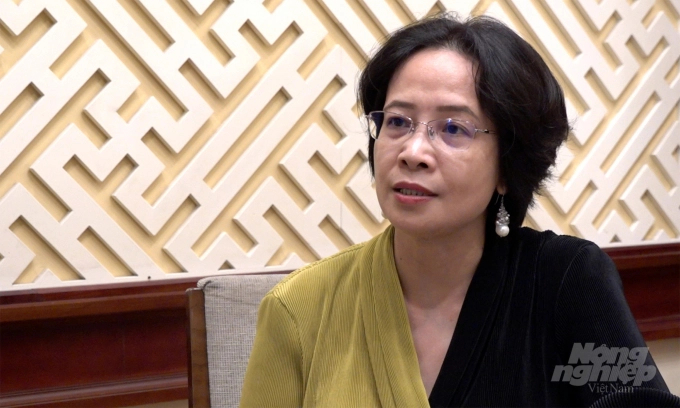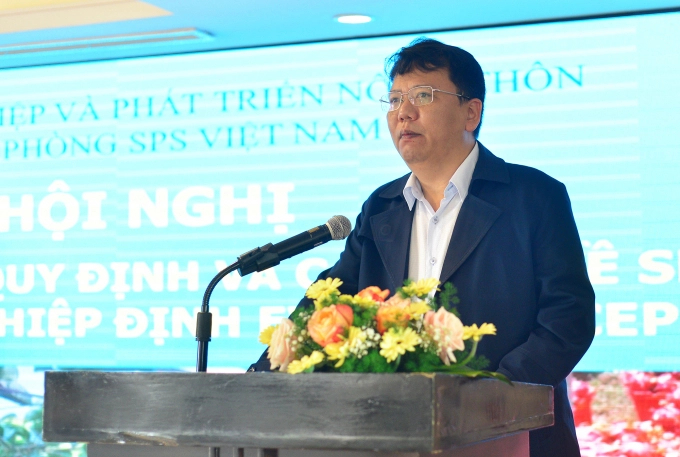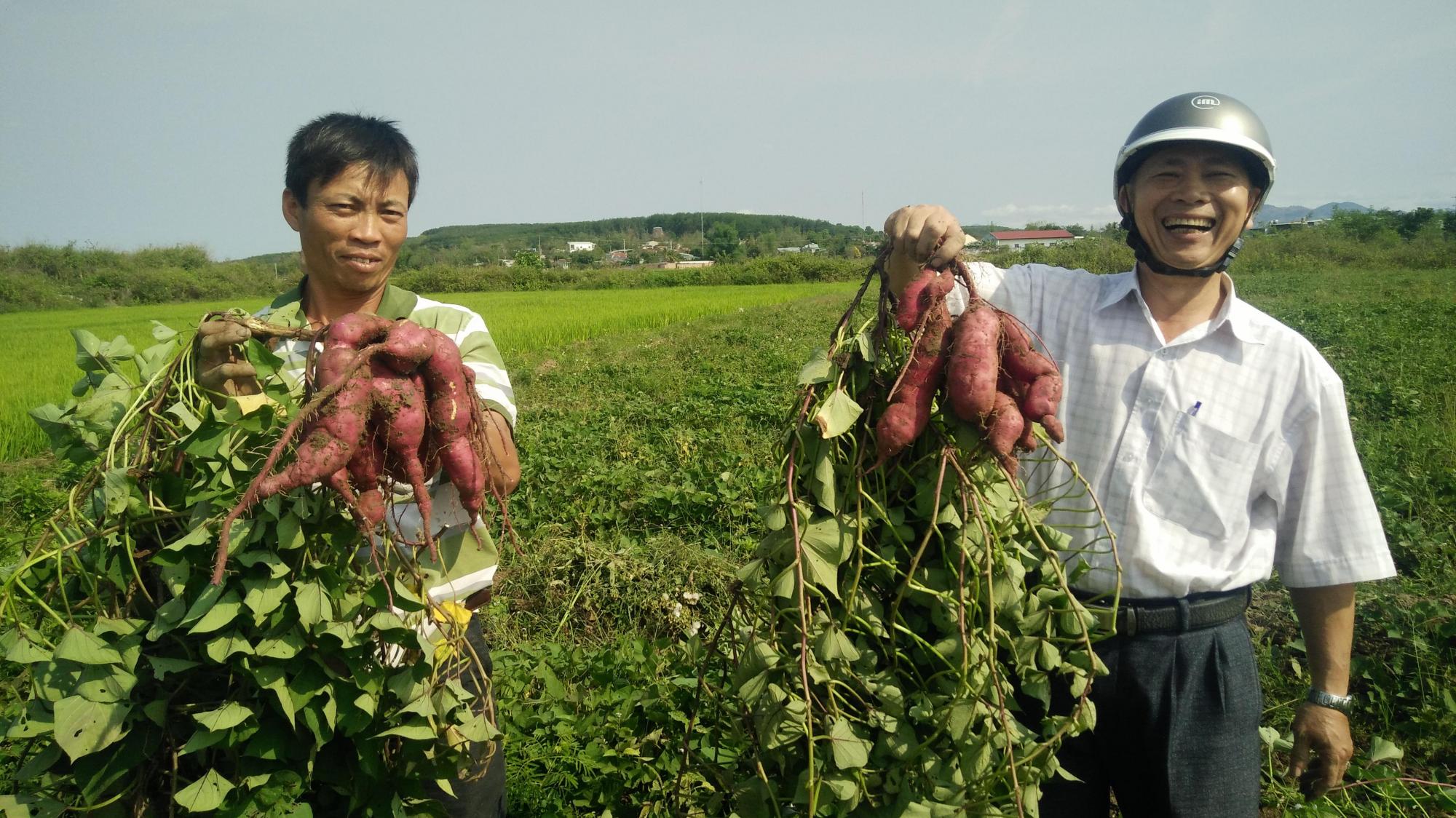As a businessman with many years of experience in doing business in the Chinese market, Ms. Nguyen Thi Lan Huong, CEO of Viet Phuc Production & Import-Export Joint Stock Company, commented that the nature of Vietnam’s climate is favorable, the soil is suitable for growing sweet potatoes. The people of China and many countries in the region appreciate and love this agricultural product.

Ms. Nguyen Thi Lan Huong, CEO of Viet Phuc Import-Export & Production Joint Stock Company. Picture: Ba thang.
Sweet potatoes, including purple sweet potatoes, are sold at high prices in Europe, Australia and some Northeast Asian countries. In the supermarket, 1 kilogram of potatoes can cost up to several hundred thousand Dong. However, in Vietnam, sweet potato growers still face uncertainties. According to Ms. Huong, the main reason is that there has been a lack of focus on manufacturing consumption, as well as trade promotion and opening up export markets.
Viet Phuc Company could not make people “think” on their own fields, researched and surveyed, and was approved by Vinh Long Provincial People’s Committee to approve the project of linkage to build sweet potato supply chain model for domestic consumption and export services in 2021 period -2024.
So far, the company has chosen to breed disease-free varieties through tissue culture with a yield of around 25 tons/ha; Complete the planting process, build factories, connect packaging plants and even consumption partners in China.
“The Chinese side is expected to inspect the sweet potato growing area and packing plant online this week. Hopefully this will get the protocol signed between the two sides, giving the sweet potato industry a chance to turn back. lots of potential and space,” Ms. Huong said.
Sweet potatoes are grown throughout the country. In particular, the Binh Tan district of Binh Long province, which is considered the sweet potato capital, grows to about 13,000 hectares with an estimated yield of 300,000 tons/year. Just by selling 1 or 2 prices above the cost of production, people can make a big profit.
However, the price of sweet potatoes has fluctuated in recent years, sometimes up to several hundred Dong/kg. The General Department of Customs (Treasury) report shows that the export turnover of sweet potato reached only US$20.6 million in the first 8 months of 2022, down 21.8% from the same period in 2021. Sweet potato leaves alone valued at $515,000, down 9.9%.
These days, Ms. Nguyen Thi Lan Huong is busy planting the planting area in preparation for the inspection of the Chinese side. A new potato harvest, due to begin in early November, coincides with this calendar. Therefore, people must master the technology to be able to communicate with Chinese authorities in case of need.
Interspersed with the excitement and excitement that filled all the assembly halls in Vinh Long, Dong Thap, etc., there was certain confusion about the new method of fertilization, from seed to production according to the planting area code recorded in the article. Keep a journal of the effectiveness of using pesticides on your country’s approved list.
“Through the survey, I found that farmers have changed their perception and are clearly showing their determination to produce according to standards and regulations to apply technology, improve quality and performance. That’s the trend. indispensable position of the agricultural industry, also the most effective way to develop new markets and retain stable customers,” said Ms. Huong.
Based on experience from online testing of some fruits and agricultural products, Viet Phuc Company, in close coordination with the Ministry of Agriculture and Rural Development, the local sub-department of crop production and crop protection, has prepared a plan to reduce all expenses for the people. In the case of newly planted areas, companies support the implementation of mixed cultures and cultivation techniques in order to secure the income of the farmers.
Actually tested sweet potatoes, including purple sweet potatoes, have many outstanding benefits, such as: This is even one of the preeminent crops for alum and saline soils thanks to the advantage of being able to spread the harvest all year round. The profit after deducting all costs per hectare of potato cultivation is up to VND 25-30 million.
Because the sweet potato is a short-term crop, people in some places “often arbitrarily break the plan” when they encounter market fluctuations. If the price rises, the area is continuously expanded. Conversely, when prices fall, people are willing to uproot rice or some other short-term crop to plant rice. The history of “supporting the consumption” of sweet potatoes therefore became an issue, especially in the two years affected by Covid-19, and China had a period to stop importing this item.
Strictly follow the inspection process
From the time the information emerged that sweet potatoes were considered a priority item for official export by China, many phone calls were received with the SPS office in Vietnam. Most want to learn more about phytosanitary requirements, growing area code monitoring, and the remote risk analysis process.
Excited that people are becoming more interested in market information, says Dr. Ngo Xuan Nam, deputy director of the SPS office in Vietnam, shared, “The General Administration of Customs of China plans to carry out risk analysis and review the management system for sweet potato growing areas and packing plants of export companies, which is necessary and in line with international standards practices methods exercises”.

DR. Ngo Xuan Nam: If sweet potatoes are allowed to be officially exported to China, that will be very good news for farmers and agribusiness in Vietnam.
According to Nam, the Chinese side will combine online inspection and field investigation. Companies and cooperatives must therefore contact the responsible local administrative authority. In addition, sweet potato growers must be synchronous and comprehensive with pests, farm management records, storage records, pre-processing, transportation, etc.
In particular, regarding the issue of pest control and quality assessment of production and export facilities, the Chinese side is expected to review a number of key items, including: company location map; Field pest control and prevention methods, including field pest survey records, survey systems and pest control measures.
Also, producers must mentally prepare to review the pest control stages and clean the sweet potato bottom; Specific and detailed statistics on the use of pesticides such as active substance name, time of application, concentration, frequency and area of application. In addition, the technical staff of the warehousing business must be formally trained and records kept.

Sweet potatoes are concentrated in the Mekong Delta and some central highland provinces. Picture: BT.
Regarding the process of harvesting, processing, canning and transportation of sweet potato, the Chinese side is expected to verify the following contents: dossier of sweet potato harvest area; The company’s entire sweet potato import process from the moment it arrives at the factory, including video recording the process of importing raw materials, canning, cleaning, packaging, export and transportation links, transportation, storage and processing.
As China continues to adhere to the “Zero Covid” policy, your side is expected to review the disease prevention and control measures during the production and processing of sweet potatoes for export. In which there is the management of employee health; Prevention and control requirements during handling, storage and transportation of sweet potatoes; Prevention and control requirements during production and processing, emergency measures, cleaning and disinfection of the environment, etc.
“If sweet potatoes are allowed to be officially exported to China, it will be very good news for farmers and agribusiness in Vietnam. I hope everyone joins hands for responsible and sustainable agriculture and help farmers live healthily in their own fields as Minister Le Minh Hoan wishes,” said Mr. Ngo Xuan Nam.

